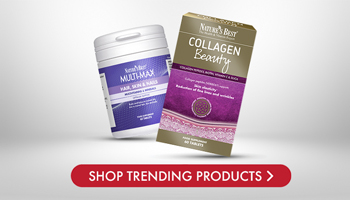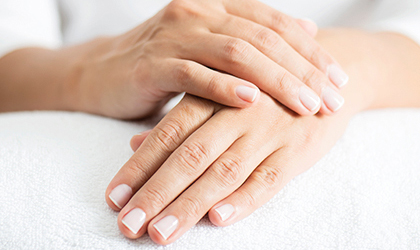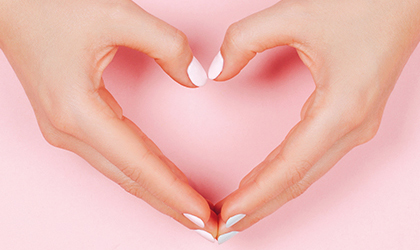
Did you know the shape, texture and colour of your nails reveal all sorts of secrets about the health of your body? Yes, vital clues about your overall wellbeing may be lying just at the end of your fingertips. Here’s how to spot them…
Spoon nails
Koilonychias – or the more comically named ‘spoon-shaped’ nails, describes a condition where the nails turn concave. Sometimes, this can be caused by the overuse of cleaning agents or chemicals wearing the nail away. But more commonly, it’s the result of an iron deficiency. A simple blood test should determine if you’re low in iron, which can be treated with a high strength supplement (ahem, our Iron 14mg as Citrate would do the trick).
White spots
While most people believe white spots on your nails indicate a lack of calcium in the diet, it turns out this a common misconception. Milk spots or leukonychia actually result from a more straightforward and simple explanation: you bumped or injured your nail. So, you’ll be glad to hear there’s no need to down pints of milk at the first glimpse of a white spot on your fingertips! The solution: strengthen your nails to prevent future injury by using grapeseed oil or a vitamin-E based hand cream.
Brittle nails
Brittle nails tend to be fragmented at the edges, crumbly, and have a yellowish tinge. If it’s just your fingernails that are affected, then this brittleness could stem from something external like harsh cleaning agents. However, if your toenails are also brittle, then you could have a nail infection.
Nail pitting
Ever wondered what explains those strange dimples and pinhead-sized dents on your fingernails? This nail malformation is usually triggered by allergic or immune related skin problems. Some doctors recommend taking a high-strength vitamin D supplement to help with this.
Transverse grooves
Coined after the French physician Joseph Honore Simon Beau who first noticed the condition, ‘Beau’s Lines’ are single or multiple transverse furrows on the nail plate. These grooves can manifest from injury to the nail root, damage from certain medication like chemotherapy, or if you suffer from cold hands and feet. Usually, nature will run its course and this abnormality will dissipate after six months. A quick word on cold hands and feet problems though: it’s best to avoid exposing your hands to fluctuating temperatures, and you may even consider Veintain® to help with circulation of your extremities. This specialist formula contains Ginkgo 6000 and the warming spices of ginger and cinnamon extracts.
Nail clubbing
Often described as ‘watch-glass nails’, this condition causes your nails to become round and convex, with the tips of your fingers appearing swollen. This complaint is often associated with issues relating to the heart or the lungs. To rule out any serious health issues, it’s wise to visit your GP for a routine examination.
Longitudinal grooves
This abnormality produces grooves that run from the nail bed to the edge, giving the surface a lacklustre and uneven finish. Though this condition is usually a tell-tale sign of old age, it could also signal low levels of vitamin B12. To improve the appearance of your nails, replenish your hands with an age-related moisturiser. And to ‘up’ your natural stocks of vitamin B12, make sure you eat plenty of meat, fish, dairy and eggs, or take a quality vitamin B12 supplement
Split nails
Split nails occur when the nail bed becomes broken and separated, which can be unsightly and inconvenient (especially when it keeps catching on your clothes – argh!) Typically, this problem is caused by mechanical or chemical damage to the nail root. This good news is that you can use clear polish or nail glue to cement it back together, and it should grow out in time. Phew.
Cracked nails
Dry and brittle nails can stem from all sorts of things: the natural ageing process, the long-term use of nail polish, and exposure to moist conditions such as swimming or washing up. If this is coupled with a yellowish hue though, it’s more likely to be a fungal infection. Concerned? Best get it checked out by your GP.
Nail-biting
Can’t stop gnawing away at your nails when you’re feeling stressed or anxious? Although this habit can be an immensely satisfying way to curb your cortisol levels, each nibble and bite is not worth the long-term health implications for your fingertips. More scientifically known as onychophagia, nail biting doesn’t only damage your nails, but it can cause a transfer of bacteria from your mouth to your nails. This can lead to infections like paronychia, where the skin around your nails becomes red, raw and tender – ouch! But nail biting goes beyond just an unsightly, vulgar habit. Often, it can manifest from a mental health condition such as an anxiety disorder.
Thankfully, all the damage done to your nails is totally reversible, granted you kick the bad habit and change your behaviour. Of course, the real issue is how! Firstly, it’s a good idea to keep your nails short so there’s literally nothing left to chew, bite or gnaw away at. You could also try distracting your hands and mouth by chewing gum or squeezing a stress ball. And perhaps you could finally invest in that anti-biting varnish you’ve been meaning to get? It’s also worth considering Rhodiola Rosea if you’re juggling lots of balls or our Theanine supplement.
Pale and white nails
Very pale nails or white nails with a darker rim could signal an underlying health concern. To rule out anything serious, visit your GP.
Black lines
If you’ve spotted a black stripe lingering on your nail, then despite looking a little strange, it’s likely to be a benign mole. Although probably nothing to worry about, it’s best to this little guy checked out by your doctor. Noticed a change in shape? See a dermatologist to get to the bottom of it.
Bluish nails
A strange bluish tint on your talons may indicate a circulatory problem. Visit your GP if you begin to see blue.
Yellow nails
The most common cause of a yellowish hue is a fungal infection. As the infection worsens, your nails may thicken, crumble and even retract. Fortunately, this is a pretty easy condition to treat with over-the-counter anti-fungal medication.
Seeing red?
If you’re a serial biter, picker or peeler, then any redness around your nail could simply result from inflammation. But on a more serious note, this could also signal an allergic reaction. Nail polish often contains harsh chemicals like camphor and formaldehyde, which can sometimes spark allergies. To avoid any unwanted reactions, opt for non-toxic nail varnishes where possible.
You Might Also Like

Keri
Keri Filtness has worked in the Nutrition Industry for 19 years. She is regularly called upon for her professional comments on health and nutrition related news. Her opinions have been featured by BBC3, Prima, Vitality, The Mirror, Woman’s Own and Cycling Weekly, amongst others. She has also worked one to one with journalists, analysing their diets and health concerns and recommending changes and additions, where appropriate.
View More



